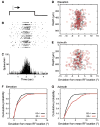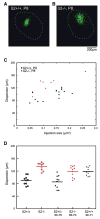Development of precise maps in visual cortex requires patterned spontaneous activity in the retina
- PMID: 16337917
- PMCID: PMC2562716
- DOI: 10.1016/j.neuron.2005.09.015
Development of precise maps in visual cortex requires patterned spontaneous activity in the retina
Abstract
The visual cortex is organized into retinotopic maps that preserve an orderly representation of the visual world, achieved by topographically precise inputs from the lateral geniculate nucleus. We show here that geniculocortical mapping is imprecise when the waves of spontaneous activity in the retina during the first postnatal week are disrupted genetically. This anatomical mapping defect is present by postnatal day 8 and has functional consequences, as revealed by optical imaging and microelectrode recording in adults. Pharmacological disruption of these retinal waves during the first week phenocopies the mapping defect, confirming both the site and the timing of the disruption in neural activity responsible for the defect. Analysis shows that the geniculocortical miswiring is not a trivial or necessary consequence of the retinogeniculate defect. Our findings demonstrate that disrupting early spontaneous activity in the eye alters thalamic connections to the cortex.
Figures








References
-
- Bansal A, Singer JH, Hwang BJ, Xu W, Beaudet A, Feller MB. Mice lacking specific nicotinic acetylcholine receptor subunits exhibit dramatically altered spontaneous activity patterns and reveal a limited role for retinal waves in forming ON and OFF circuits in the inner retina. J Neurosci. 2000;20:7672–7681. - PMC - PubMed
-
- Catalano SM, Shatz CJ. Activity-dependent cortical target selection by thalamic axons. Science. 1998;281:559–562. - PubMed
Publication types
MeSH terms
Substances
Grants and funding
LinkOut - more resources
Full Text Sources
Other Literature Sources
Molecular Biology Databases

